These highlights do not include all the information needed to use REZIPRES® safely and effectively. See full prescribing information for REZIPRES®. REZIPRES® injection for intravenous use Initial U.S. Approval: 2016
REZIPRES by
Drug Labeling and Warnings
REZIPRES by is a Prescription medication manufactured, distributed, or labeled by Eton Pharmaceuticals, Inc., SINTETICA SA, SINTETICA-BIOREN SA. Drug facts, warnings, and ingredients follow.
Drug Details [pdf]
REZIPRES- ephedrine hydrochloride injection, solution
Eton Pharmaceuticals, Inc.
----------
HIGHLIGHTS OF PRESCRIBING INFORMATIONThese highlights do not include all the information needed to use REZIPRES® safely and effectively. See full prescribing information for REZIPRES®.
REZIPRES® injection for intravenous use Initial U.S. Approval: 2016 INDICATIONS AND USAGEREZIPRES® is an alpha- and beta- adrenergic agonist and a norepinephrine-releasing agent that is indicated for the treatment of clinically important hypotension occurring in the setting of anesthesia. (1) DOSAGE AND ADMINISTRATION
DOSAGE FORMS AND STRENGTHS
CONTRAINDICATIONSNone. (4) WARNINGS AND PRECAUTIONSADVERSE REACTIONSMost common adverse reactions during treatment: nausea, vomiting, and tachycardia. (6) To report SUSPECTED ADVERSE REACTIONS, contact Eton Pharmaceuticals at 1-888-450-0568 or FDA at 1-800-FDA-1088 or www.fda.gov/medwatch. DRUG INTERACTIONS
See 17 for PATIENT COUNSELING INFORMATION. Revised: 6/2021 |
FULL PRESCRIBING INFORMATION
1 INDICATIONS AND USAGE
REZIPRES® is indicated for the treatment of clinically important hypotension occurring in the setting of anesthesia.
2 DOSAGE AND ADMINISTRATION
2.1 General Dosage and Administration Instructions
REZIPRES® 47 mg/mL must be diluted before administration as an intravenous bolus to achieve the desired concentration. Dilute with normal saline or 5% dextrose in water.
REZIPRES® 9.4 mg/mL can be either used as provided at 9.4 mg/mL or it can be diluted, with 5% Dextrose Injection or 0.9% Sodium Chloride Injection, to achieve the desired concentration, before administration as an intravenous bolus.
REZIPRES® 4.7 mg/mL is a premixed formulation. Do not dilute prior to use.
- REZIPRES® is a clear, colorless solution. Discard any unused portion.
- Inspect parenteral drug products visually for particulate matter and discoloration prior to administration, whenever solution and container permit. Do not use if the solution is not clear or if particulate matter is present.
2.2 Dosing for the Treatment of Clinically Important Hypotension in the Setting of Anesthesia
The recommended dosages for the treatment of clinically important hypotension in the setting of anesthesia is an initial dose of 4.7 mg to 9.4 mg administered by intravenous bolus. Administer additional boluses as needed, not to exceed a total dosage of 47 mg.
- Adjust dosage according to the blood pressure goal (i.e., titrate to effect).
2.3 Prepare a 4.7 mg/mL Solution for Bolus Intravenous Administration
REZIPRES® 47 mg/mL
Withdraw 47 mg (1 mL of 47 mg/mL) of REZIPRES® 47 mg/mL and dilute with 9 mL of 5% Dextrose Injection or 0.9% Sodium Chloride Injection.
Withdraw an appropriate dose of the 4.7 mg/mL solution prior to bolus intravenous administration.
REZIPRES® 9.4 mg/mL
Withdraw 5 mL of REZIPRES® 9.4 mg/mL and dilute with 5 mL of 5% Dextrose Injection or 0.9% Sodium Chloride Injection.
Withdraw an appropriate dose of the 4.7 mg/mL solution prior to bolus intravenous administration.
3 DOSAGE FORMS AND STRENGTHS
REZIPRES® 47 mg/mL
REZIPRES® 47 mg/mL is a clear, colorless solution available in a one point cut clear colorless glass 2 mL single-dose ampule that contains 1 mL of solution, corresponding to 47 mg of ephedrine hydrochloride, equivalent to 38 mg of ephedrine base.
REZIPRES® 47 mg/5 mL (9.4 mg/mL)
REZIPRES® 47 mg/5mL is a clear, colorless solution available in a one point cut clear colorless glass single-dose ampule equivalent to 38 mg/5 mL ephedrine base (9.4 mg/mL ephedrine hydrochloride, equivalent to 7.7 mg/mL ephedrine base).
REZIPRES® 23.5 mg/5 mL (4.7 mg/mL)
REZIPRES® 23.5 mg/ 5mL is a clear, colorless solution, available in a one point cut clear colorless glass single-dose ampule, equivalent to 19 mg/5 mL of ephedrine base (4.7 mg/mL ephedrine hydrochloride, equivalent to 3.8 mg/mL of ephedrine base).
5 WARNINGS AND PRECAUTIONS
5.1 Pressor Effect with Concomitant Oxytocic Drugs
Serious postpartum hypertension has been described in patients who received both a vasopressor (i.e., methoxamine, phenylephrine, ephedrine) and an oxytocic (i.e., methylergonovine, ergonovine) [ see Drug Interactions (7) ]. Some of these patients experienced a stroke. Carefully monitor the blood pressure of individuals who have received both REZIPRES® and an oxytocic.
5.2 Tolerance and Tachyphylaxis
Data indicate that repeated administration of ephedrine can result in tachyphylaxis. Clinicians treating anesthesia-induced hypotension with REZIPRES® should be aware of the possibility of tachyphylaxis and should be prepared with an alternative pressor to mitigate unacceptable responsiveness.
6 ADVERSE REACTIONS
The following adverse reactions associated with the use of ephedrine were identified in the literature. Because these reactions are reported voluntarily from a population of uncertain size, it is not always possible to estimate their frequency reliably or to establish a causal relationship to drug exposure.
Gastrointestinal disorders: Nausea, vomiting
Cardiac disorders: Tachycardia, palpitations (thumping heart), reactive hypertension, bradycardia, ventricular ectopics, R-R variability
Nervous system disorders: Dizziness
Psychiatric disorders: Restlessness
7 DRUG INTERACTIONS
7.1 Interactions that Augment Pressor Effect
| Oxytocin and oxytocic drugs | |
| Clinical Impact: | Serious postpartum hypertension has been described in patients who received both a vasopressor (i.e., methoxamine, phenylephrine, ephedrine) and an oxytocic (i.e., methylergonovine, ergonovine). Some of these patients experienced a stroke. |
| Intervention: | Carefully monitor the blood pressure of individuals who have received both REZIPRES® and an oxytocic. |
| Clonidine, propofol, monoamine oxidase inhibitors (MAOIs), atropine | |
| Clinical Impact: | These drugs augment the pressor effect of ephedrine. |
| Intervention: | Carefully monitor the blood pressure of individuals who have received both REZIPRES® and any of these drugs. |
7.2 Interactions that Antagonize the Pressor Effect
| Clinical Impact: | These drugs antagonize the pressor effect of ephedrine. |
| Intervention: | Carefully monitor the blood pressure of individuals who have received both REZIPRES® and any of these drugs. |
| Examples: | α-adrenergic antagonists, β-adrenergic receptor antagonists, reserpine, quinidine, mephentermine. |
7.3 Other Drug Interaction
| Guanethidine | |
| Clinical Impact: | REZIPRES® may inhibit the neuron blockage produced by guanethidine, resulting in loss of antihypertensive effectiveness. |
| Intervention: | Clinician should monitor patient for blood pressor response and adjust the dosage or choice of pressor accordingly. |
| Rocuronium | |
| Clinical Impact: | REZIPRES® may reduce the onset time of neuromuscular blockade when used for intubation with rocuronium if administered simultaneously with anesthetic induction. |
| Intervention: | Be aware of this potential interaction. No treatment or other interventions are needed. |
| Epidural anesthesia | |
| Clinical Impact: | REZIPRES® may decrease the efficacy of epidural blockade by hastening the regression of sensory analgesia. |
| Intervention: | Monitor and treat the patient according to clinical practice. |
| Theophylline | |
| Clinical Impact: | Concomitant use of REZIPRES® may increase the frequency of nausea, nervousness, and insomnia. |
| Intervention: | Monitor patient for worsening symptoms and manage symptoms according to clinical practice. |
| Cardiac glycosides | |
| Clinical Impact: | Giving REZIPRES® with a cardiac glycoside, such as digitalis, may increase the possibility of arrhythmias. |
| Intervention: | Carefully monitor patients on cardiac glycosides who are also administered REZIPRES®. |
8 USE IN SPECIFIC POPULATIONS
8.1 Pregnancy
Risk Summary
Available data from randomized studies, case series, and reports of ephedrine sulfate use in pregnant women have not identified a drug-associated risk of major birth defects, miscarriage, or adverse maternal or fetal outcomes. However, there are clinical considerations [see Clinical Considerations].
In animal reproduction studies, decreased fetal survival and fetal body weights were observed in the presence of maternal toxicity after normotensive pregnant rats were administered 60 mg/kg intravenous ephedrine sulfate (12 times the maximum recommended human dose (MRHD) of 47 mg/day of ephedrine hydrochloride). No malformations or embryofetal adverse effects were observed when pregnant rats or rabbits were treated with intravenous bolus doses of ephedrine sulfate during organogenesis at doses 1.9 and 7.7 times the MRHD, respectively [See data].
The estimated background risk of major birth defects and miscarriage for the indicated population are unknown. All pregnancies have a background risk of birth defect, loss, or other adverse outcomes. In the U.S. general population, the estimated background risk of major birth defects and miscarriage in clinically recognized pregnancies is 2 to 4% and 15 to 20%, respectively.
Clinical Considerations
Disease-associated maternal and/or embryofetal risk
Untreated hypotension associated with spinal anesthesia for cesarean section is associated with an increase in maternal nausea and vomiting. A decrease in uterine blood flow due to maternal hypotension may result in fetal bradycardia and acidosis.
Fetal/Neonatal Adverse Reactions
Cases of potential metabolic acidosis in newborns at delivery with maternal ephedrine exposure have been reported in the literature. These reports describe umbilical artery pH of ≤7.2 at the time of delivery [see Clinical Pharmacology 12.3]. Monitoring of the newborn for signs and symptoms of metabolic acidosis may be required. Monitoring of infant’s acid-base status is warranted to ensure that an episode of acidosis is acute and reversible.
Data
Animal Data
Decreased fetal body weights were observed when pregnant rats were administered intravenous bolus doses of 60 mg/kg ephedrine sulfate (12 times the maximum recommended human dose (MRHD) based on body surface area) from Gestation Day 6-17. This dose was associated with evidence of maternal toxicity (decreased body weight of dams and abnormal head movements). No malformations or fetal deaths were noted at this dose. No effects on fetal body weight were noted at 10 mg/kg (1.9 times the MRHD).
No evidence of malformations or embryo-fetal toxicity were noted in pregnant rabbits administered intravenous bolus doses up to 20 mg/kg ephedrine sulfate (7.7 times the MRHD based on body surface area) from Gestation Day 6 to 20. This dose was associated with expected pharmacological maternal effects (increased respiration rate, dilated pupils, piloerection).
Decreased fetal survival and body weights in the presence of maternal toxicity (increased mortality) were noted when pregnant dams were administered intravenous bolus doses of 60 mg/kg epinephrine sulfate (approximately 12 times the MRHD based on body surface area) from GD 6 through Lactation Day 20. No adverse effects were noted at 10 mg/kg (1.9 times the MRHD).
8.2 Lactation
Risk Summary
A single published case report indicates that ephedrine is present in human milk. However, no information is available on the effects of the drug on the breastfed infant or the effects of the drug on milk production. The developmental and health benefits of breastfeeding should be considered along with the mother's clinical need for REZIPRES® and any potential adverse effects on the breastfed child from REZIPRES® or from the underlying maternal condition.
8.4 Pediatric Use
Safety and effectiveness in pediatric patients have not been established.
Animal Toxicity Data
In a study in which juvenile rats were administered intravenous bolus doses of 2, 10, or 60 mg/kg ephedrine sulfate daily from Postnatal Day 35 to 56, an increased incidence of mortality was noted at the high dose of 60 mg/kg. The no-adverse-effect level was 10 mg/kg (approximately 1.9 times a maximum daily dose of 47 mg ephedrine hydrochloride in a 60 kg person based on body surface area).
8.5 Geriatric Use
Clinical studies of ephedrine did not include sufficient numbers of subjects aged 65 and over to determine whether they respond differently from younger subjects. Other reported clinical experience has not identified differences in responses between the elderly and younger patients. In general, dose selection for an elderly patient should be cautious, usually starting at the low end of the dosing range, reflecting the greater frequency of decreased hepatic, renal, or cardiac function, and of concomitant disease or other drug therapy. This drug is known to be substantially excreted by the kidney, and the risk of adverse reactions to this drug may be greater in patients with impaired renal function. Because elderly patients are more likely to have decreased renal function, care should be taken in dose selection, and it may be useful to monitor renal function.
8.6 Renal Impairment
Ephedrine and its metabolite are excreted in urine. In patients with renal impairment, excretion of ephedrine is likely to be affected with a corresponding increase in elimination half-life, which will lead to slow elimination of ephedrine and consequently prolonged pharmacological effect and potentially adverse reactions. Monitor patients with renal impairment carefully after the initial bolus dose for adverse events.
10 OVERDOSAGE
Overdose of REZIPRES® can cause a rapid rise in blood pressure. In the case of an overdose, careful monitoring of blood pressure is recommended. If blood pressure continues to rise to an unacceptable level, parenteral antihypertensive agents can be administered at the discretion of the clinician.
11 DESCRIPTION
REZIPRES® is an alpha- and beta-adrenergic agonist and a norepinephrine-releasing agent. Ephedrine Hydrochloride Injection, 4.7 mg/mL is a clear, colorless, sterile solution for intravenous injection. The chemical name of ephedrine hydrochloride is (1R,2S)-(-)-2-methylamino-1-phenyl-1-propanol hydrochloride, and the molecular weight is 201.7 g/mol. Its structural formula is depicted below:
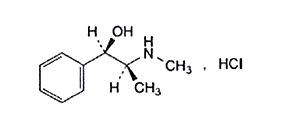
Ephedrine hydrochloride is freely soluble in water, soluble in ethanol and stable in aqueous solution.
REZIPRES® 47 mg/mL
REZIPRES® 47 mg/ml is a clear, colorless, sterile solution for intravenous injection. It must be diluted before intravenous administration. Each mL contains ephedrine hydrochloride 47 mg (equivalent to 38 mg ephedrine base) in water for injection. The pH is adjusted with sodium hydroxide and hydrochloric acid if necessary. The pH range is 5.0 to 6.5.
REZIPRES® 47 mg/5 mL (9.4 mg/mL)
REZIPRES® 9.4 mg/ml is a clear, colorless, sterile solution for intravenous injection. It can either be used as provided or diluted at 4.7 mg/mL, before intravenous administration. Each mL contains ephedrine hydrochloride 9.4 mg (equivalent to 7.7 mg ephedrine base) and sodium chloride 6.0 mg in water for injection. The pH is adjusted with sodium hydroxide and hydrochloric acid if necessary. The pH range is 5.0 to 6.5.
REZIPRES® 23.5 mg/5 mL (4.7 mg/mL)
REZIPRES® 4.7 mg/ml is a clear, colorless, sterile solution for intravenous injection. It must not be diluted prior to use. Each mL contains ephedrine hydrochloride 4.7 mg (equivalent to 3.8 mg ephedrine base) and sodium chloride 7.5 mg in water for injection. The pH is adjusted with sodium hydroxide and hydrochloric acid if necessary. The pH range is 5.0 to 6.5.
12 CLINICAL PHARMACOLOGY
12.1 Mechanism of Action
Ephedrine is a sympathomimetic amine that directly acts as an agonist at α- and β-adrenergic receptors and indirectly causes the release of norepinephrine from sympathetic neurons. Pressor effects by direct alpha- and beta-adrenergic receptor activation are mediated by increases in arterial pressures, cardiac output, and peripheral resistance. Indirect adrenergic stimulation is caused by norepinephrine release from sympathetic nerves.
12.2 Pharmacodynamics
Ephedrine stimulates heart rate and cardiac output and variably increases peripheral resistance; as a result, ephedrine usually increases blood pressure. Stimulation of the α-adrenergic receptors of smooth muscle cells in the bladder base may increase the resistance to the outflow of urine. Activation of β- adrenergic receptors in the lungs promotes bronchodilation.
The overall cardiovascular effect from ephedrine is the result of a balance among α-1 adrenoceptor- mediated vasoconstriction, β-2 adrenoceptor-mediated vasoconstriction, and β-2 adrenoceptor-mediated vasodilatation. Stimulation of the β-1 adrenoceptors results in positive inotrope and chronotrope action.
Tachyphylaxis to the pressor effects of ephedrine may occur with repeated administration [see Warnings and Precautions 5.2].
12.3 Pharmacokinetics
Publications studying pharmacokinetics of oral administration of (-)-ephedrine support that (-)-ephedrine is metabolized into norephedrine. However, the metabolism pathway is unknown. Both the parent drug and the metabolite are excreted in urine. Limited data after IV administration of ephedrine support similar observations of urinary excretion of drug and metabolite. The plasma elimination half-life of ephedrine following oral administration was about 6 hours. Ephedrine crosses the placental barrier [see Use in Specific Populations 8.1].
13 NONCLINICAL TOXICOLOGY
13.1 Carcinogenesis, Mutagenesis, Impairment of Fertility
Carcinogenesis: Two-year feeding studies in rats and mice conducted under the National Toxicology Program (NTP) demonstrated no evidence of carcinogenic potential with ephedrine sulfate at doses up to 10 mg/kg/day and 27 mg/kg/day (approximately 2 times and 3 times the maximum human recommended dose on a mg/m2 basis, respectively).
Mutagenesis: Ephedrine sulfate tested negative in the in vitro bacterial reverse mutation assay, the in vitro mouse lymphoma assay, the in vitro sister chromatid exchange, the in vitro chromosomal aberration assay, and the in vivo rat bone marrow micronucleus assay.
Impairment of Fertility: there was no impact on fertility or early embryonic development in a study in which male rats were administered intravenous bolus doses of 0, 2, 10, or 60 mg/kg ephedrine sulfate (up to 12 times the MRHD of 47 mg of ephedrine hydrochloride based on body surface area) for 28 days prior to mating and through gestation and females were treated for 14 days prior to mating through Gestation Day 7.
14 CLINICAL STUDIES
The evidence for the efficacy of REZIPRES® is derived from the published literature. Increases in blood pressure following administration of ephedrine were observed in 14 studies, including 9 where ephedrine was used in pregnant women undergoing neuraxial anesthesia during Cesarean delivery, 1 study in non-obstetric surgery under neuraxial anesthesia, and 4 studies in patients undergoing surgery under general anesthesia. Ephedrine has been shown to raise systolic and mean blood pressure when administered as a bolus dose following the development of hypotension during anesthesia.
16 HOW SUPPLIED/STORAGE AND HANDLING
REZIPRES® is a clear, colorless solution supplied as follows:
| NDC Number | Strength | Presentation |
| 71863-212-01 | 47 mg/ml | 2 mL clear glass, single-dose ampule filled with 1 mL |
| 71863-212-02 | 2 mL ampules filled with 1 mL packaged in a carton of 10 | |
| 71863-211-05 |
47 mg/5 mL (9.4 mg/ml) | 5 mL clear glass, single-dose ampule |
| 71863-211-06 | 5 mL ampules packaged in a carton of 10 | |
| 71863-210-05 |
23.5 mg/5 mL (4.7 mg/ml) | 5 mL clear glass, single-dose ampule |
| 71863-210-06 | 5 mL ampules packaged in a carton of 10 |
Store REZIPRES® at 20°C to 25°C (68°F to 77°F); excursions permitted to 15°C to 30°C (59°F to 86°F) [see USP Controlled Room Temperature].
For single-dose only. The diluted solution should not be held for more than 4 hours at room temperature or for more than 24 hours under refrigerated conditions. Discard any unused portion.
17 PATIENT COUNSELING INFORMATION
If applicable, inform patient, family member, or caregiver that certain medical conditions and medications might influence how REZIPRES® works.
Manufactured for:
Eton Pharmaceuticals, Inc.
Deer Park, IL 60010
USA
Rev. 06/2021
REZIPRES® 47 mg / mL - Label
NDC: 71863-212-01 Rx Only
REZIPRES®
Ephedrine Hydrochloride Injection
47 mg/ 1 mL
equivalent to 38 mg ephedrine base
Must Be Diluted
1 mL Single Dose Ampule For Intravenous Use Only
Store at 20 to 25°C (68 to 77°F)
[See USP Controlled Room Temperature].
Does not contain preservatives or sulfites.
Discard unused portion.

REZIPRES® 47 mg / mL - Carton
STERILE INJECTION NDC: 71863-212-02 10 Single Dose Ampules 1 mL Each
REZIPRES®
Ephedrine Hydrochloride Injection
47 mg / mL
equivalent to 38 mg ephedrine base
Must Be Diluted
For Intravenous Use Only
Preservative Free- Contains no Sulfites Rx Only 10 Single Dose Ampules x 1 mL
Each mL contains:
47 mg Ephedrine Hydrochloride (equivalent to 38 mg ephedrine base), Sodium Chloride, Water for Injection.
pH may be adjusted with Sodium Hydroxide and/or Hydrochloric Acid.
Recommended Dosage and Directions: See Prescribing Information.
Store at 20°C to 25°C (68°F to 77°F); excursions permitted to 15°C to 30°C (59°F to 86°F) [see USP Controlled Room Temperature].
Discard Unused Portion.
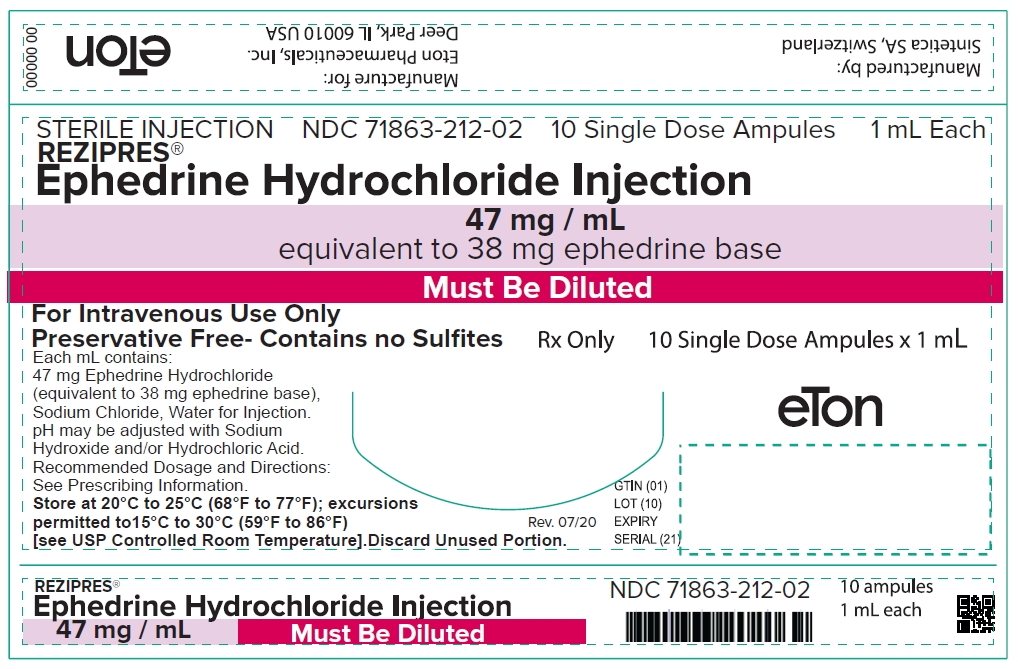
REZIPRES® 9.4 mg / mL - Label
NDC: 71863-211-05 5 mL single-dose ampule
REZIPRES®
Ephedrine Hydrochloride Injection
47 mg/ 5 mL (9.4 mg/ mL)
(equivalent to 38 mg/5 mL ephedrine base)
Premixed Formulation - Can Be Diluted
Store at 20 to 25°C (68 to 77°F) [See USP Controlled Room Temperature].
Does not contain preservatives or sulfites. Rx Only
Discard unused portion.
For Intravenous Use Only
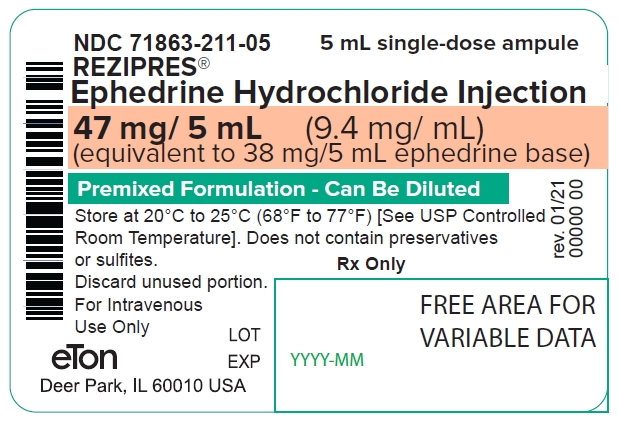
REZIPRES® 9.4 mg / mL - Carton
STERILE INJECTION NDC: 71863-211-06 10 Single Dose Ampules 5 mL Each
REZIPRES®
Ephedrine Hydrochloride Injection
47 mg / 5 mL (9.4 mg/ mL)
(equivalent to 38 mg/5 mL ephedrine base)
Premixed Formulation- Can Be Diluted
For Intravenous Use Only Rx Only 10 Single Dose Ampules x 5 mL
Preservative Free- Contains no Sulfites
Each mL contains:
9.4 mg Ephedrine Hydrochloride (equivalent to 7.7 mg ephedrine base), Sodium Chloride, Water for Injection.
pH may be adjusted with Sodium Hydroxide and/or Hydrochloric Acid.
Recommended Dosage and Directions: See Prescribing Information.
Store at 20°C to 25°C (68°F to 77°F); excursions permitted to 15°C to 30°C (59°F to 86°F) [see USP Controlled Room Temperature].
Discard Unused Portion
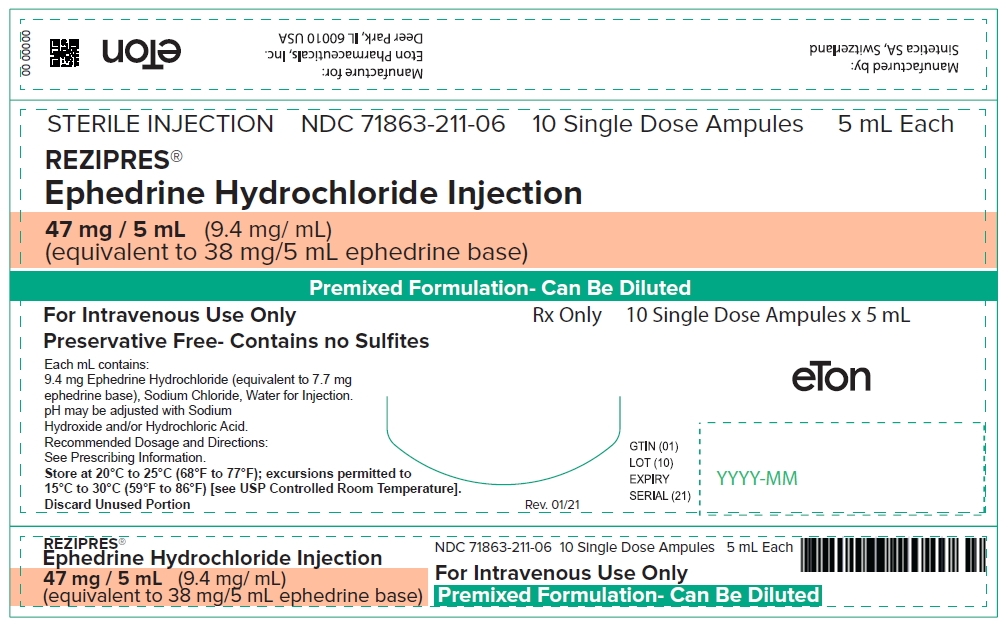
REZIPRES® 4.7 mg / mL - Label
NDC: 71863-210-05 5 mL single-dose ampule
REZIPRES®
Ephedrine Hydrochloride Injection
23.5 mg/ 5 mL (4.7 mg/ mL)
(equivalent to 19 mg/5 mL ephedrine base)
Premixed Formulation - Do Not Dilute
Store at 20 to 25°C (68 to 77°F) [See USP Controlled Room Temperature].
Does not contain preservatives or sulfites. Rx Only
Discard unused portion.
For Intravenous Use Only
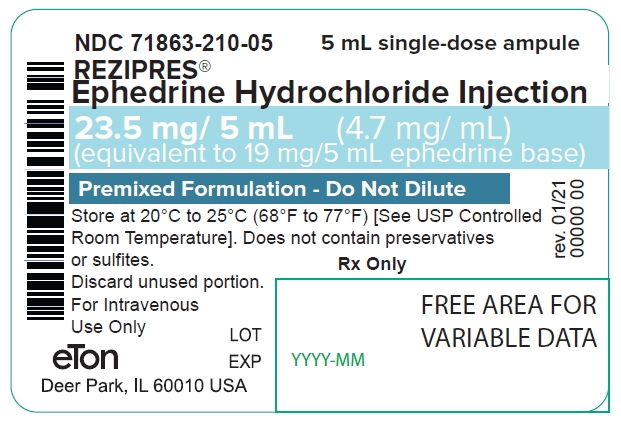
REZIPRES® 4.7 mg / mL - Carton
STERILE INJECTION NDC: 71863-210-06 10 Single Dose Ampules 5 mL Each
REZIPRES®
Ephedrine Hydrochloride Injection
23.5 mg / 5 mL (4.7 mg/ mL)
(equivalent to 19 mg/5 mL ephedrine base)
Premixed Formulation - Do Not Dilute
For Intravenous Use Only Rx Only 10 Single Dose Ampules x 5 mL
Preservative Free- Contains no Sulfites
Each mL contains:
4.7 mg Ephedrine Hydrochloride (equivalent to 3.8 mg ephedrine base), Sodium Chloride, Water for Injection.
pH may be adjusted with Sodium Hydroxide and/or Hydrochloric Acid.
Recommended Dosage and Directions: See Prescribing Information.
Store at 20°C to 25°C (68°F to 77°F); excursions permitted to 15°C to 30°C (59°F to 86°F) [see USP Controlled Room Temperature].
Discard Unused Portion
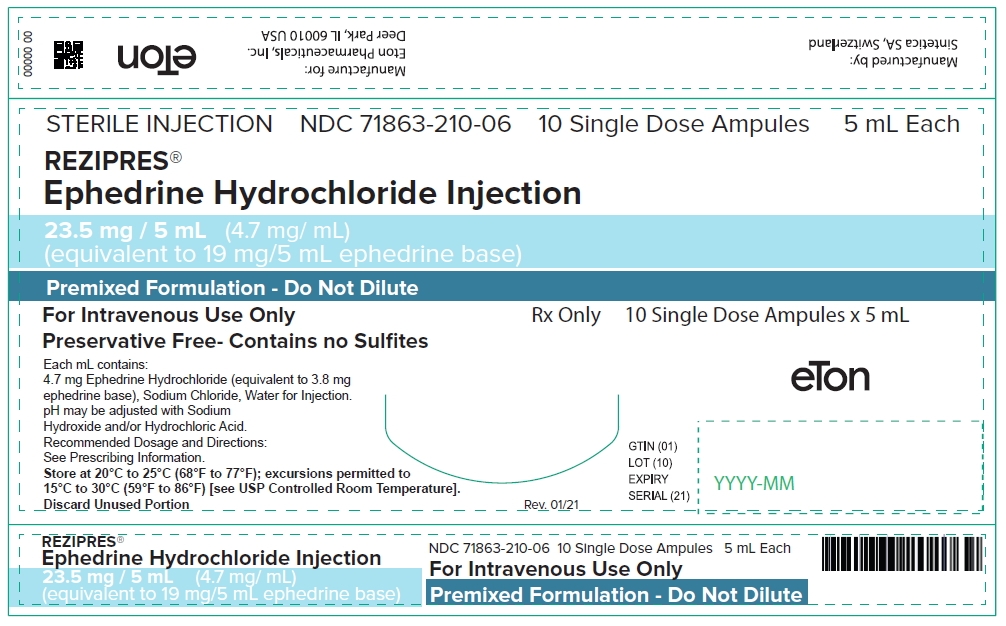
| REZIPRES
ephedrine hydrochloride injection, solution |
||||||||||||||||||||
|
||||||||||||||||||||
|
||||||||||||||||||||
|
||||||||||||||||||||
|
||||||||||||||||||||
|
||||||||||||||||||||
| REZIPRES
ephedrine hydrochloride injection, solution |
||||||||||||||||||||
|
||||||||||||||||||||
|
||||||||||||||||||||
|
||||||||||||||||||||
|
||||||||||||||||||||
|
||||||||||||||||||||
| REZIPRES
ephedrine hydrochloride injection, solution |
||||||||||||||||||||
|
||||||||||||||||||||
|
||||||||||||||||||||
|
||||||||||||||||||||
|
||||||||||||||||||||
|
||||||||||||||||||||
| Labeler - Eton Pharmaceuticals, Inc. (080870465) |
| Registrant - SINTETICA SA (480895478) |
| Establishment | |||
| Name | Address | ID/FEI | Business Operations |
|---|---|---|---|
| SINTETICA SA | 480895478 | manufacture(71863-212, 71863-211, 71863-210) , analysis(71863-212, 71863-211, 71863-210) , label(71863-212, 71863-211, 71863-210) , pack(71863-212, 71863-211, 71863-210) | |
| Establishment | |||
| Name | Address | ID/FEI | Business Operations |
|---|---|---|---|
| SINTETICA-BIOREN SA | 483148768 | analysis(71863-212, 71863-211, 71863-210) | |
Trademark Results [REZIPRES]
Mark Image Registration | Serial | Company Trademark Application Date |
|---|---|
 REZIPRES 90060774 not registered Live/Pending |
Eton Pharmaceuticals, Inc. 2020-07-19 |
© 2025 FDA.report
This site is not affiliated with or endorsed by the FDA.